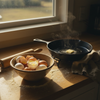Master the Art: How to Sauté Onions to Perfection
Ah, the humble onion. It might make you cry during prep, but the transformation that happens in a hot pan? Pure kitchen magic. Whether you're building the foundation for a soul-warming French onion soup or adding that perfect caramelized topping to your weekend burger masterpiece, knowing how to sauté onions properly is like having a culinary superpower in your back pocket.
At DI ORO, we believe great cooking starts with great technique—and the right tools that won't let you down mid-flip. So grab your favorite DI ORO spatula (you know, the one America's Test Kitchen crowned as the best all-purpose spatula), and let's turn those tear-jerking bulbs into golden, aromatic heaven. Check out our Seamless Series for the perfect tools to assist you.
The Science Behind Sautéing Onions
Before we dive into slicing and dicing, let's get a little nerdy about what's actually happening when you sauté onions. Raw onions contain natural sulfur compounds—the ones responsible for that eye-stinging sensation and sharp flavor. When heat enters the chat, these compounds break down and natural sugars emerge, creating that gorgeous transformation from pungent to sweet.
The key difference between simply sautéed and fully caramelized onions isn't just time—it's chemistry. Sautéing (10-15 minutes) softens and sweetens, while caramelization (30-60 minutes) breaks down those sugars completely, creating hundreds of new flavor compounds and that deep mahogany color we all drool over.
Choosing Your Onion Variety
Not all onions are created equal when it comes to the sauté pan. Each variety brings its own personality to your dish:
- Yellow onions: The all-purpose MVP with the perfect balance of sweetness and pungency when cooked. These are your go-to for almost any sautéing project.
- Sweet onions (Vidalia, Walla Walla): Higher sugar content means they caramelize beautifully and quickly. Perfect when you want pronounced sweetness.
- Red onions: Slightly milder flavor with gorgeous color that fades somewhat during cooking. Excellent for dishes where you'll serve the onions as a visible topping.
- White onions: Sharper flavor and maintain more crispness when cooked. Great for shorter cooking applications where you want some texture.
For most applications—whether you're learning how to sauté onions for burgers, steak, or as a base for other veggies—yellow onions deliver consistent, delicious results. But don't be afraid to mix it up! A combination of yellow and sweet onions creates amazing depth when caramelized.
Tools of the Trade: Setting Up for Success
Before you start transforming those onions, let's make sure you're equipped for the journey. The right tools make all the difference between "meh" and "magnificent."
Essential Equipment
- A heavy-bottomed skillet or sauté pan: The weight matters! Thin pans create hot spots that lead to uneven cooking and burned spots. A 10-12 inch pan is ideal for 2-3 large onions.
- A quality spatula: DI ORO's Seamless Series Spatula is perfect here—heat-resistant to 600°F and designed with a flexible edge that can scrape up every bit of flavor from the pan without scratching your cookware.
- A sharp chef's knife: Dull knives crush onion cells, releasing more of those tear-inducing compounds. Sharp knives mean less crying and cleaner cuts.
With our award-winning spatulas, you can confidently scrape up every caramelized bit without worrying about melting, warping, or—worst of all—introducing forever chemicals into your carefully crafted dish. Because what touches your food matters just as much as the food itself.
The Perfect Slice: Prep Like a Pro
How you cut your onions directly impacts how they'll cook. For classic sautéed or caramelized onions, the French cut (or julienne) creates the ideal shape:
- Slice off the stem and root ends
- Cut the onion in half from pole to pole (not through the equator)
- Peel off the papery skin and first layer
- Place flat-side down and slice into half-moons, following the natural lines of the onion
- Aim for uniform thickness—about ¼ inch for standard sautéed onions, slightly thinner for faster cooking, slightly thicker for caramelizing
Consistency is key! When all your slices are the same thickness, they'll cook at the same rate, giving you that perfect, even golden color without some pieces burning while others remain undercooked.
Basic Technique: How to Sauté Onions Like a Chef
Now for the main event! This method is your foundation for all things sautéed onion—from a quick aromatic base for garlic and other vegetables to the start of your caramelization journey.
The Standard Sauté (10-15 Minutes)
- Start cold: Place your heavy pan on the stove and add 1-2 tablespoons of cooking fat. A combination of butter and olive oil gives you the best of both worlds—flavor and a higher smoke point.
- Heat gradually: Turn to medium heat and let your pan warm up slowly. Patience here prevents burning.
- Add onions and season: Once your fat is shimmering (or butter is melted and just starting to foam), add your sliced onions. Sprinkle with a pinch of kosher salt—this helps draw out moisture and speeds up the cooking process.
- The initial sizzle: You should hear a gentle sizzle, not a harsh sear. If the sound is too aggressive, lower your heat.
- Stir occasionally: Use your DI ORO spatula to move the onions every minute or so, making sure they're cooking evenly. The flexible edge is perfect for scraping up any bits that start to stick.
- Watch the transformation: Over 10-15 minutes, your onions will gradually become translucent, then golden, softening and shrinking as they release moisture.
The magic of sautéing onions is in the visual cues. They'll tell you exactly where you are in the process: translucent with no color (5 minutes), softened with golden edges (10 minutes), or evenly golden with some deeper spots (15 minutes). Each stage has its perfect use in different recipes.
How to Sauté Onions and Garlic Together
A classic combination that forms the foundation of countless recipes, but timing is everything when sautéing onions and garlic together. Garlic burns much faster than onions, turning bitter when overdone.
For perfect results: Start with your onions and follow the standard method. When the onions are about 80% done (soft and starting to turn golden), add minced or sliced garlic to the pan. Cook for just 1-2 minutes more until the garlic becomes fragrant but not browned. This sequence ensures both ingredients reach their peak flavor without either burning.
How to Sauté Onions and Peppers
This dynamic duo features in everything from fajitas to Italian sausage sandwiches, but peppers and onions cook at different rates. For perfect texture in both:
- Start with onions alone, cooking for about 5 minutes until they begin to soften
- Add sliced peppers (aim for similar thickness to your onion slices)
- Continue cooking another 7-10 minutes, stirring occasionally
- The peppers should be tender-crisp while the onions develop golden edges
This method ensures your peppers maintain some texture while your onions develop that perfect sweetness. For fajitas specifically, consider cranking the heat higher for the last few minutes to get some char on both vegetables. Learn more about dicing onions at Serious Eats.
The Art of Caramelization: Taking Your Onions to the Next Level
If sautéed onions are the opening act, caramelized onions are the headliner—deep, complex, and absolutely worth the wait. The difference between sautéed onions vs caramelized onions isn't just time; it's a complete transformation in flavor, texture, and versatility.
While anyone can cook onions until they're soft, achieving that perfect mahogany color and jammy consistency takes a bit more finesse. With our DI ORO spatula in hand (the one that won't melt even at 600°F), you're ready to embark on this culinary journey of patience and reward.
The Full Caramelization Process (30-60 Minutes)
- Set the stage: Start with a wider pan if possible—more surface area means faster evaporation and better browning. For 3-4 large onions, a 12-inch skillet works beautifully.
- Begin as you would for sautéing: Cold pan, fat first (2 tablespoons butter + 1 tablespoon olive oil), medium heat.
- Add onions and salt: Once your fat is ready, add all your sliced onions and a generous pinch of salt. They'll look like they're overflowing, but will cook down dramatically.
- The first 10 minutes: Stir occasionally until onions soften and become translucent.
- Adjust the heat: Reduce to medium-low. This is where patience becomes your secret ingredient.
- The middle stage (10-30 minutes): Stir every 5-10 minutes, scraping up any fond (those delicious browned bits) from the bottom. Your onions will gradually shrink and turn golden.
- The final stretch (30-60 minutes): As moisture evaporates and sugars break down, your onions will turn increasingly darker. Keep stirring occasionally, watching carefully to prevent burning.
- Deglaze if needed: If things start sticking too much, add a splash of water, stock, or wine to release the fond and incorporate it back into your onions.
The result? Deeply browned, intensely sweet onions that have reduced to about a quarter of their original volume. They'll have a jam-like consistency that melts in your mouth and elevates everything they touch.
Troubleshooting Your Caramelization
Even experienced cooks can hit snags when caramelizing onions. Here's how to navigate common challenges:
- Onions burning too quickly: Your heat is too high. Immediately lower the temperature and consider adding a tablespoon of water to cool the pan down.
- Taking forever to brown: Your heat might be too low, or your pan might be overcrowded. Try increasing heat slightly or using a larger pan next time.
- Uneven coloring: You're probably not stirring thoroughly enough. Use your DI ORO spatula to really get into the corners and ensure all onions get equal pan time.
- Too dry and starting to burn: Add small amounts of liquid (water, broth, wine) one tablespoon at a time to keep things moving without steaming.
Remember, caramelization isn't something you can rush. Those deep flavors develop slowly as natural sugars break down—a process that simply can't be accelerated beyond a certain point without burning.
Specialty Applications: How to Sauté Onions for Specific Dishes

Different dishes call for different approaches to onion preparation. Let's break down some popular applications and how to tailor your technique for each.
How to Sauté Onions for Burgers
For burger toppings, you want onions that are sweet and soft but still have some body—not completely broken down. Here's the perfect method:
- Slice onions slightly thicker (about ⅓ inch)
- Use a combination of butter and oil for rich flavor
- Cook over medium heat for 12-15 minutes until golden but still slightly firm
- For extra flavor, add a splash of Worcestershire sauce in the last minute of cooking
- Season with salt and freshly ground pepper
These onions add the perfect sweet-savory balance to a juicy burger without sliding off or disappearing into the other toppings. Pile them high on your patty and watch your burger game reach new heights!
How to Sauté Onions for Steak
A perfectly cooked steak deserves onions that complement rather than compete. For this classic pairing:
- Slice onions into slightly thicker half-moons
- Use a higher ratio of butter to oil for richness
- Add a sprig of fresh thyme or rosemary to the pan
- Cook until deeply golden but not completely broken down (about 15-20 minutes)
- In the final minute, add a splash of red wine or beef stock and let it reduce
- Finish with a grind of black pepper
These onions create a luxurious bed for your steak or can be served alongside as the perfect accompaniment. The slight reduction of wine or stock creates a mini sauce that captures all the flavor without requiring a separate pan.
Quick-Pickled Sautéed Onions
Want to take your onion game in a completely different direction? Try this chef-inspired technique that combines the sweetness of sautéing with the bright tang of pickling—perfect for tacos, sandwiches, or grain bowls:
- Sauté sliced red onions for just 5 minutes until softened but still vibrant
- Remove from heat and immediately add 2 tablespoons of apple cider vinegar or lime juice
- Sprinkle with a pinch of sugar and salt
- Let sit for 5-10 minutes as they cool
The result is a beautiful hybrid—onions with the mellowness of being cooked but the bright acidity of pickles. They'll retain more of their gorgeous purple color than fully caramelized red onions, making them as beautiful as they are delicious.
Storage Solutions: Make Once, Enjoy All Week
One of the best cooking efficiency hacks is preparing a big batch of sautéed or caramelized onions to use throughout the week. Your future self will thank you when dinner prep time is cut in half!
Refrigerator Storage
Properly cooled sautéed or caramelized onions will keep beautifully in the refrigerator:
- Allow onions to cool completely before storing
- Transfer to an airtight container
- Refrigerate for up to 5 days
- Reheat in a skillet over medium-low heat or microwave briefly
Freezer Storage for Longer-Term Planning
For meal prep beyond a few days, freezing is your friend:
- Cool onions completely
- Portion into ice cube trays for small amounts or freezer-safe containers
- If using trays, freeze until solid, then transfer cubes to a freezer bag
- Label with the date and contents
- Freeze for up to 3 months
These frozen flavor bombs can be added directly to soups, stews, and sauces without thawing. For other applications, thaw overnight in the refrigerator or use the defrost setting on your microwave.
Beyond the Basics: Creative Flavor Additions
Once you've mastered the fundamental techniques, it's time to play with flavor profiles that can take your sautéed or caramelized onions in exciting new directions.
Sweet and Savory Variations
- Balsamic finish: Add 1-2 tablespoons of balsamic vinegar during the final minutes of caramelization for a tangy-sweet depth.
- Maple-bourbon: Deglaze your caramelized onions with a splash of bourbon and a drizzle of maple syrup for a decadent topping perfect for pork or chicken.
- Herbed onions: Add fresh thyme, rosemary, or sage during the last 5 minutes of cooking for an aromatic twist.
- Spiced variation: Incorporate a pinch of cumin, smoked paprika, or curry powder halfway through cooking for globally-inspired flavors.
With your trusty DI ORO spatula—designed to reach every corner of your pan without scratching—you'll be able to incorporate these additions evenly, ensuring perfect flavor distribution throughout your onions. Watch a video on advanced onion sautéing tips on YouTube.
Remember, cooking is as much about creativity as it is technique. Once you understand the fundamentals of how to sauté onions, you can let your culinary imagination run wild, creating signature versions that become your personal kitchen trademark.
How to Sauté Onions and Garlic Together: A Perfect Partnership
Onions and garlic—name a more iconic culinary duo. When properly sautéed together, they create the aromatic foundation for countless dishes across global cuisines. But timing this partnership requires finesse, as garlic burns much faster than onions and can quickly turn bitter. Here's how to orchestrate this flavor symphony with your trusty DI ORO spatula at the ready.
The Sequential Method (Recommended)
- Start with onions first: Heat your pan with fat, add sliced onions, and cook for 5-7 minutes until they begin to soften.
- Add garlic later: Once onions are translucent, add minced or sliced garlic and continue cooking for just 1-2 minutes until fragrant but not browned.
- Keep stirring: Use your DI ORO spatula to keep everything moving, especially after adding the garlic.
This method ensures your garlic remains fragrant without burning while allowing your onions to develop proper sweetness. It's the technique professional chefs rely on for everything from pasta sauces to stir-fries.
The Protective Method (For Longer Cooking)
If you're planning to caramelize your onions but still want garlic flavor:
- Start with onions alone: Begin the caramelization process with just onions for the first 15-20 minutes.
- Create a well: Push the partially caramelized onions to the sides of the pan, creating a space in the center.
- Add garlic to the well: Place minced garlic in this center space with a little extra oil or butter.
- Cook briefly: Let the garlic sizzle for 30-60 seconds until fragrant.
- Incorporate together: Use your heat-resistant DI ORO spatula to fold the onions and garlic together, then continue caramelizing.
This technique allows you to infuse garlic flavor without risking the bitter taste of burnt garlic, even during longer cooking processes. Your spatula's precision edge helps you create that perfect center well without damaging your cookware.
Sautéed Onions and Peppers: A Colorful Combination
Learning how to sauté onions and peppers together creates a versatile mixture that's perfect for fajitas, pasta, omelets, and countless other dishes. The key is managing their different cooking times while maximizing flavor development.
Perfect Pepper and Onion Sauté
- Prep with precision: Slice onions into 1/4-inch half-moons and peppers into 1/4-inch strips of similar length.
- Heat management: Start with a medium-high heat to get good initial color.
- Onions first: Add onions to the hot oil and cook for 2-3 minutes until they just begin to soften.
- Add peppers: Incorporate sliced bell peppers (any color works, though a mix creates beautiful contrast).
- Season thoughtfully: Add salt, freshly ground pepper, and any desired herbs or spices.
- Cook with care: Continue cooking for 7-10 minutes, stirring occasionally with your DI ORO spatula until vegetables are tender-crisp with charred edges.
The beauty of this technique is the textural contrast—onions become sweet and soft while peppers retain a slight bite. Your forever-chemical-free DI ORO spatula ensures nothing sticks to the pan, preserving those beautiful caramelized bits that deliver maximum flavor.
Flavor Variations for Onion and Pepper Sautés
- Italian-inspired: Add dried oregano, basil, and a splash of balsamic vinegar during the final minute.
- Mexican fajita style: Incorporate cumin, chili powder, and a squeeze of lime juice at the end.
- Mediterranean: Include dried thyme, a pinch of cinnamon, and finish with fresh parsley.
- Asian fusion: Add ginger with the garlic, and finish with a splash of soy sauce and sesame oil.
These vibrant combinations demonstrate how mastering a simple technique like sautéing onions and peppers opens doors to global flavors. With your DI ORO tools in hand, these culinary journeys become not just accessible, but joyful. Watch a tutorial on sautéing onions and peppers on YouTube.
From Novice to Pro: Elevating Your Onion Game
As with any culinary skill, sautéing onions is a technique that rewards practice and attention. Here are some advanced tips to take your onion game from good to spectacular:
Pro Tips for Onion Perfection
- Use the right pan: Heavy-bottomed stainless steel or cast iron provides the even heat distribution that helps onions cook uniformly without scorching.
- Listen to your onions: The sound of sizzling should be steady but not aggressive—a gentle sizzle indicates perfect temperature.
- Trust your nose: The aroma will shift from sharp to sweet as onions cook—a reliable indicator of their development.
- Taste as you go: The only true way to know if your onions are ready is to taste them at different stages.
- Master temperature adjustments: Learning when to raise or lower heat comes with practice, but pays enormous dividends in your cooking.
With your DI ORO spatula—designed to withstand temperatures up to 600°F without leaching harmful chemicals—you can confidently adjust and taste throughout the cooking process, developing the intuition that separates good cooks from great ones.
The Secret to Restaurant-Quality Results
Want to know why restaurant dishes often have that extra depth of flavor? Professional chefs understand that properly sautéed or caramelized onions aren't just ingredients—they're flavor foundations. They take the time to develop these components fully, never rushing the process.
The next time you're tempted to turn up the heat to speed things along, remember: patience isn't just a virtue in onion cookery—it's the secret ingredient. Your DI ORO tools are built to last through countless hours of cooking, supporting your journey from basic techniques to culinary mastery. Explore our Chef Series for more specialized tools.
Conclusion: Your Onion Odyssey
We've journeyed from basic sautéing to deep caramelization, explored specialty applications for burgers and steaks, learned how to pair onions with garlic and peppers, and discovered pro tips to elevate your technique. The humble onion, when treated with knowledge and respect, transforms from a tear-inducing kitchen staple to the soul of your cooking.
Whether you're making a quick weeknight stir-fry or dedicating an hour to developing perfectly caramelized onions for French onion soup, the techniques you've learned here will serve you in countless culinary creations. And with your DI ORO kitchen tools—crafted from pro-grade, forever-chemical-free materials—you have the perfect partners for this flavor journey.
Remember that cooking is both science and art. The science gives us understanding of why onions transform as they cook; the art comes in developing your personal touch and preferences. Some dishes might call for barely-cooked, still-crunchy onions, while others demand the deep umami notes that only patient caramelization can provide.
As you continue experimenting, you'll develop your own signature methods and variations. Perhaps you'll become known for your perfectly caramelized onion jam or the way you sauté onions and peppers for the best fajitas your friends have ever tasted. That's the joy of cooking—taking fundamental techniques and making them uniquely yours.
So heat your pan, grab your DI ORO spatula, and embark on your next culinary adventure. From all of us at DI ORO, happy cooking!
Looking for the perfect tools to master your onion-cooking techniques? DI ORO's award-winning spatulas and kitchen tools have earned accolades from America's Test Kitchen, Cook's Illustrated, and Food Network for their performance, durability, and safety. Our pro-grade silicone is forever-chemical free, because what touches your food matters. Explore our collection at dioro.com and elevate your cooking experience today.
Explore more recipes and tips on our blog:
- Three Ways for a Summer Boil
- Kale Egg Bake
- A New Approach to Garlic
- Strawberry Cheesecake Ice Cream
- Roasted Asparagus
Frequently Asked Questions
How do you sauté onions?
To sauté onions, start by heating a pan over medium heat and adding a small amount of oil or butter. Once the fat is hot, add sliced or chopped onions and cook them, stirring frequently, until they are soft and translucent, which usually takes about 5 to 10 minutes.
Should I sauté onions in butter or oil?
Both butter and oil can be used to sauté onions, and each has its own benefits. Oil has a higher smoke point, making it suitable for higher heat cooking, while butter adds a rich flavor but can burn more easily, so it’s often used at lower temperatures or in combination with oil.
What's the difference between sauteing and caramelizing onions?
Sautéing onions involves cooking them until they are soft and translucent, usually over medium heat for a relatively short time. Caramelizing onions requires cooking them slowly over low heat for a longer period, allowing the natural sugars to break down and develop a deep, sweet flavor and golden-brown color.
How to caramelize onions?
To caramelize onions, slice them thinly and cook them in a pan with a bit of oil or butter over low heat. Stir them occasionally, allowing them to cook slowly for about 30 to 45 minutes, until they become soft, brown, and sweet, enhancing their natural sugars.
Do you sauté onions with the lid on or off?
Sauté onions with the lid off to allow moisture to evaporate, which helps them to soften and develop flavor without steaming. Keeping the lid off ensures the onions cook evenly and achieve the desired texture and translucency.
What are the steps for sautéing?
Begin by adding a small amount of oil or butter to a heated pan on medium heat. Add the onions, stirring frequently, and cook until they are soft and translucent, which typically takes 5 to 10 minutes. Adjust the heat as needed and continue stirring to prevent burning, achieving evenly cooked onions.




